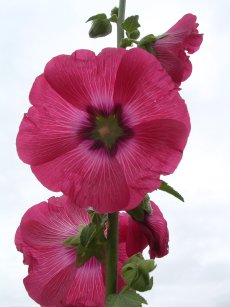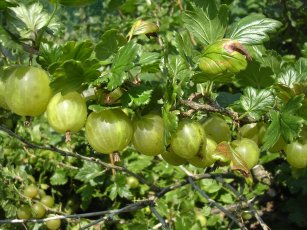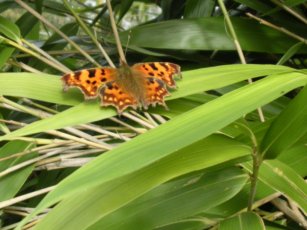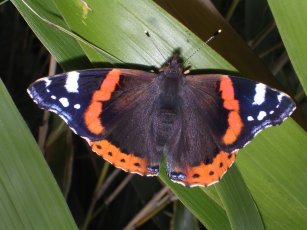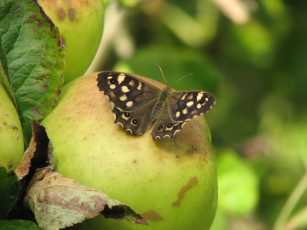Down the garden
This is not a typical "English country garden", being neither formal nor particularly well-kept. It includes areas which were previously a working yard near farm buildings, part of an old farmhouse garden, and part of an old cherry orchard. The soil is fairly heavy, as the garden lies within the High Weald area of Kent (an area identified by soil and topography, typified by heavy clay soils, naturally acidic particularly on the higher land). The site is at an altitude of 115 metres (377 feet) above sea level, gently sloping towards the North. Although this means that it is a cold, relatively late site, the sloping land means that cold air drains away, so frost damage is less common here than on some warmer sites.
In some parts of the garden, the lie of the land allows good drainage, and deep cultivation over the years has resulted in soils which produce good crops of fruit and vegetables. In other areas, groundworks in the past have left the subsoil almost exposed. The poor soil here is not suitable for gardening, but is ideal for the establishment of wild flowers which might otherwise be smothered by grasses.
We have tried to take advantage of these variations within the garden, whilst taking a fairly "low maintenance" approach to gardening. We grow fruit and vegetables; various traditional "cottage garden" flowers grow themselves; a range of wild flowers are now doing the same (following some initial encouragement). As a bonus, a wide range of wildlife are also attracted by this - and we have tried to improve the habitat to help some of the less common types.
All these photographs were taken in or from our garden or house.
This page shows only the plants and animals from our garden - but we've also found several interesting artefacts in the garden, which now appear on a separate page.
You can click on any of the photographs to see a full size version (NB some browsers fit the resulting image to their window, a further click on the image or on the "full screen logo at bottom right may be necessary to view the image full-size).
You'll find a (partial) list of species (and links to more photographs) at the bottom of this page. As we'd accumulated several interesting photos of holly blue butterflies, eggs, caterpillars and parasitoids, we've put them together into a page of their own. We've also put a heap more photos (without notes, many not yet identified) onto a couple more pages. One page is of those species we've identified, the other is of photos we've not yet got round to identifying. Please let us know if you think there's anything particularly unusual in these, or if you think we've incorrectly identified any of these photographs.
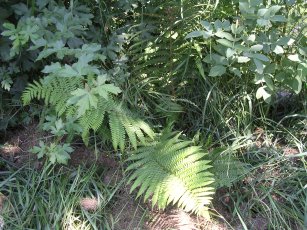 But we have also worked to encourage a range of wildlife.
We planted this hedge in 1995 (about the same time as these webpages started).
It is now well established, and John laid it in the Westmoreland style in early 2014 to provide maximum benefit to wildlife
When we first moved here, we saw occasional signs of snakes and slow-worms and knew that a range of wild birds visited the garden.
We removed the recently planted leylandii (x Cupressocyparis leylandii) hedge and replaced it with
native hedging species, including hawthorn, field maple, hornbeam, dog rose, beech, Guelder rose,
spindle tree, blackthorn, oak, elder and holly.
But we have also worked to encourage a range of wildlife.
We planted this hedge in 1995 (about the same time as these webpages started).
It is now well established, and John laid it in the Westmoreland style in early 2014 to provide maximum benefit to wildlife
When we first moved here, we saw occasional signs of snakes and slow-worms and knew that a range of wild birds visited the garden.
We removed the recently planted leylandii (x Cupressocyparis leylandii) hedge and replaced it with
native hedging species, including hawthorn, field maple, hornbeam, dog rose, beech, Guelder rose,
spindle tree, blackthorn, oak, elder and holly.
In the photo, you can see part of the base of the hedge with field maple and dog rose. In front of the hedge is part of a bank covered in rough grass. We put prunings and other sticks, a few logs and occasional small heaps of grass clippings in this area to provide a habitat for invertebrates and small animals.
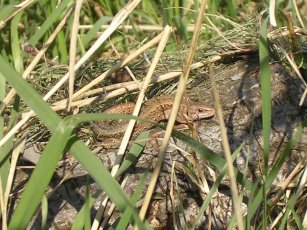 This is a common lizard, sunning itself on one of the logs in the grass bank mentioned above.
This is the kind of view you can get if you are cautious when approaching.
The next photograph shows a better view.
This is a common lizard, sunning itself on one of the logs in the grass bank mentioned above.
This is the kind of view you can get if you are cautious when approaching.
The next photograph shows a better view.
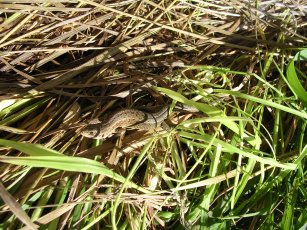 This view shows the patterns on the scales rather better (click
on the image to see a higher resolution version).
This view shows the patterns on the scales rather better (click
on the image to see a higher resolution version).
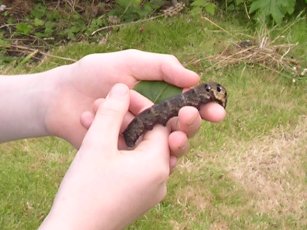 Sometimes, the "encouragement" of wild species is more a case of encouraging our childrens' interest
in wildlife. John found this elephant hawk moth caterpillar walking across the back lawn one
autumn. It was not far from some hardy Fuchsia plants (the larval food plant for this species), but
a quick check on the net made us realise that it was probably looking for a suitable site to pupate
in the soil.
Sometimes, the "encouragement" of wild species is more a case of encouraging our childrens' interest
in wildlife. John found this elephant hawk moth caterpillar walking across the back lawn one
autumn. It was not far from some hardy Fuchsia plants (the larval food plant for this species), but
a quick check on the net made us realise that it was probably looking for a suitable site to pupate
in the soil.
We filled a large plantpot with soil, ensuring that several different soil types, with and without dead leaves and other debris, were present at the surface in different parts of the pot. The caterpillar was placed on the soil, and a piece of fabric fixed over the top of the pot to prevent the caterpillar escaping. By the next day, the caterpillar had buried itself and started to pupate. We left the pot in a cool, shady place for the winter. Some hard frosts midwinter froze the surface soil and appeared to freeze the pupa, but we left it in it's pot.
When the weather warmed up the next spring, we moved the pupa into a fabric cage indoors (in a smaller pot of soil to ensure that it didn't dry out). Then, after a week or so.....
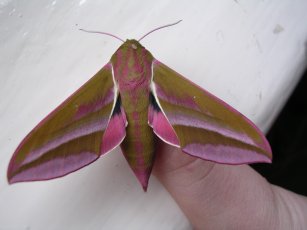 ....This beautiful moth emerged.
....This beautiful moth emerged.
This photo shows a view of the moth from the front. It was strong as well as large - John commented that it's claws were quite painful when it was on his finger. After watching it for some time, we released it in the garden in some dense undergrowth near to some nectar-bearing flowers.
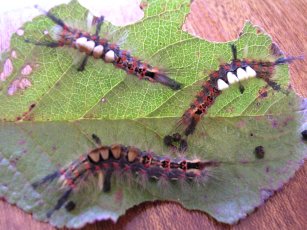 John also successfully raised several generations of vapourer moth caterpillars. The caterpillars
feed on a wide variety of deciduous shrubs and trees - here they are on a plum leaf, which seem to be
one of their favourites.
John also successfully raised several generations of vapourer moth caterpillars. The caterpillars
feed on a wide variety of deciduous shrubs and trees - here they are on a plum leaf, which seem to be
one of their favourites.
After pupating, the wingless female emerges, and remains on her coccoon. The males find the female by her scent before mating. She then lays eggs on her coccoon, then dies. When the eggs hatch, the young caterpillars first eat the eggs, then disperse on threads of silk (hence the name "vapourer").
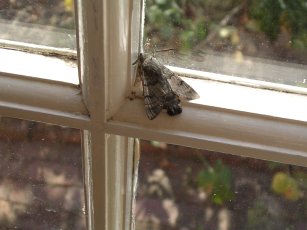 Another relatively unusual moth is the Humming bird hawk moth. This species is an occasional
migrant in Southern England; conditions in late 2003 brought a population over and the moths were
attracted to the Clerodendron trichotomum
in the garden. (This species of Clerodendron is hardy in this area, and has beautifully scented
flowers in the late summer and early autumn.)
Another relatively unusual moth is the Humming bird hawk moth. This species is an occasional
migrant in Southern England; conditions in late 2003 brought a population over and the moths were
attracted to the Clerodendron trichotomum
in the garden. (This species of Clerodendron is hardy in this area, and has beautifully scented
flowers in the late summer and early autumn.)
Humming bird hawk moths hover in front of flowers to feed, and fly during the day. They are very strong flyers, and their rapid, darting flight (as well as their feeding habits) are reminiscent of humming birds. We tried unsuccessfully several times to photograph them in the garden - but their eyesight is too good, and their reactions too quick. This one had accidentally got into the house, hence the rather unnatural setting.
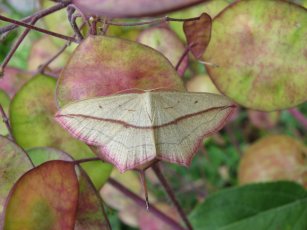 This blood vein moth (Timandra comae) flew up from a clump of mint, and landed on the greenhouse. I grabbed the camera (the books say that it is common in the south of England, but it was the first I'd seen here) but, as I approached, it flew into a Rosemary bush. I managed to get some good photos there, but then it flew off and landed on this honesty (Lunaria annua) plant, where I got a few more photos. Quite apart from the attractive appearance of the moth, I thought that the colour match with the honesty seed pods was particularly attractive. I've also cropped a section of the original image as a 1680x1050 widescreen format for use as a desktop background - you can find that version here.
This blood vein moth (Timandra comae) flew up from a clump of mint, and landed on the greenhouse. I grabbed the camera (the books say that it is common in the south of England, but it was the first I'd seen here) but, as I approached, it flew into a Rosemary bush. I managed to get some good photos there, but then it flew off and landed on this honesty (Lunaria annua) plant, where I got a few more photos. Quite apart from the attractive appearance of the moth, I thought that the colour match with the honesty seed pods was particularly attractive. I've also cropped a section of the original image as a 1680x1050 widescreen format for use as a desktop background - you can find that version here.
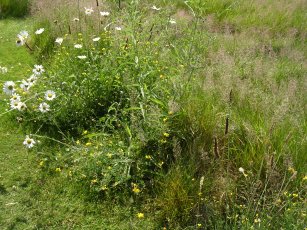 We have planted a range of native flower species in the "conservation area" (i.e. the bit where the grass is too
much trouble to mow) down the garden. In this photo you can see the small yellow flowers
of birdsfoot trefoil; the tall brown flowerheads
of ribwort plantain; the large white and yellow flowers of oxeye daisy
and the tall shoots (not yet flowering in this picture) of knapweed.
We have planted a range of native flower species in the "conservation area" (i.e. the bit where the grass is too
much trouble to mow) down the garden. In this photo you can see the small yellow flowers
of birdsfoot trefoil; the tall brown flowerheads
of ribwort plantain; the large white and yellow flowers of oxeye daisy
and the tall shoots (not yet flowering in this picture) of knapweed.
The limiting factor for insect life in grass habitats such as this is the availability of pollen and nectar as energy sources. The idea of planting these wild flowers is that not only do they look pretty, but they should also encourage a range of butterflies and other insects. Another flower which is particularly important as a source of pollen is wild carrot, which later curls in on itself to form seed heads.
Some wild flowers, such as teasel, later produce seedheads which attract seed-eating birds such as goldfinches.
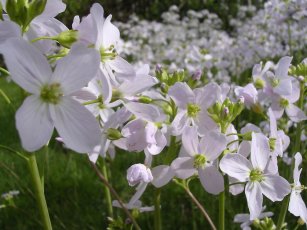 The front lawn, however, is the part of the garden seen by visitors and passers by. You might reasonably expect that it would be fed, weeded and mown to
bowling-green perfection. Our front lawn is, of course, a litle more rural than this. This colony of lady's smocks (Cardamine pratensis) flowers in the lawn each spring, and we haven't the heart to cut them down. Then.....
The front lawn, however, is the part of the garden seen by visitors and passers by. You might reasonably expect that it would be fed, weeded and mown to
bowling-green perfection. Our front lawn is, of course, a litle more rural than this. This colony of lady's smocks (Cardamine pratensis) flowers in the lawn each spring, and we haven't the heart to cut them down. Then.....
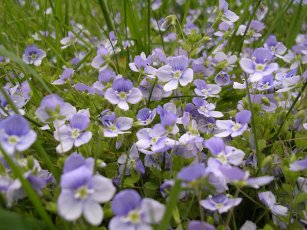 ..... in another area of the lawn, a few square metres turn blue with speedwell flowers. Not only are they quite beautiful, but the provide an excellent excuse to delay mowing the grass once again.
..... in another area of the lawn, a few square metres turn blue with speedwell flowers. Not only are they quite beautiful, but the provide an excellent excuse to delay mowing the grass once again.
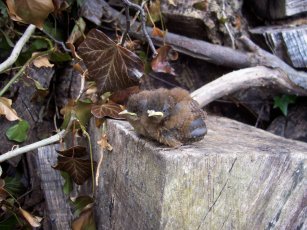 Many species of birds visit the garden and some breed here. John photographed these young wrens shortly after they had left their nest. The nest had been built in the ivy on a fence near the house, The nest was very small, but five chicks and the mother managed to fit inside. Wrens would win any "most birds in a phone box" competition, not only because of their size, but because they seem to like squeezing as many as possible into a small space. We found some information saying that wrens sometimes roost in groups in nest boxes in the winter, with up to 63 birds having been found in a single box. We have a few bluetit nest boxes in the garden, and have sometimes found signs of them being used as a winter roost by one or two birds, but no evidence of this level of multiple occupancy.
Many species of birds visit the garden and some breed here. John photographed these young wrens shortly after they had left their nest. The nest had been built in the ivy on a fence near the house, The nest was very small, but five chicks and the mother managed to fit inside. Wrens would win any "most birds in a phone box" competition, not only because of their size, but because they seem to like squeezing as many as possible into a small space. We found some information saying that wrens sometimes roost in groups in nest boxes in the winter, with up to 63 birds having been found in a single box. We have a few bluetit nest boxes in the garden, and have sometimes found signs of them being used as a winter roost by one or two birds, but no evidence of this level of multiple occupancy.
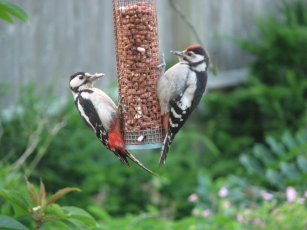 We put out feeders for birds at some times of the year. These attract a range of species, the most impressive of which are the greater spotted woodpeckers which come to the peanut feeders.In this photo, the larger bird on the right with the red crown is a young bird, which was being fed fragments of peanut by its mother on the left. The photo is not completely clear because it was taken through a window - these birds are very wary of humans.
We put out feeders for birds at some times of the year. These attract a range of species, the most impressive of which are the greater spotted woodpeckers which come to the peanut feeders.In this photo, the larger bird on the right with the red crown is a young bird, which was being fed fragments of peanut by its mother on the left. The photo is not completely clear because it was taken through a window - these birds are very wary of humans.
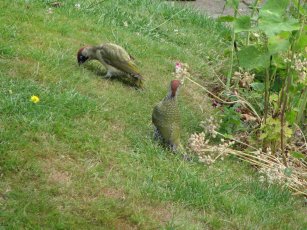 These green woodpeckers are even more nervous about humans - the usual view of this species (in our garden, or out in the countryside) is of their bright yellow/green rear departing into the distance with their characteristic up and down flight. They usually feed in areas of open grass - these two were on the back lawn, photographed from an upstairs window. If you click on the image to see the larger version, you can see the beautiful patterns on the back of the wings.
These green woodpeckers are even more nervous about humans - the usual view of this species (in our garden, or out in the countryside) is of their bright yellow/green rear departing into the distance with their characteristic up and down flight. They usually feed in areas of open grass - these two were on the back lawn, photographed from an upstairs window. If you click on the image to see the larger version, you can see the beautiful patterns on the back of the wings.
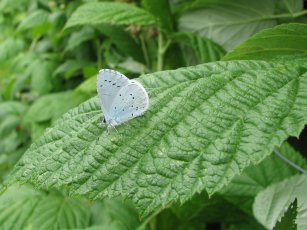 The holly blue butterfly (Celastrina argiolus) has an unusual lifecycle. As with many butterfles, the caterpillars are fairly specific regarding food plants - but, in the case of this species, caterpillars of the two generations feed on different plants. The first generation feed on holly, but the second generation (which then overwinter as pupae) feed primarily on ivy.
The holly blue butterfly (Celastrina argiolus) has an unusual lifecycle. As with many butterfles, the caterpillars are fairly specific regarding food plants - but, in the case of this species, caterpillars of the two generations feed on different plants. The first generation feed on holly, but the second generation (which then overwinter as pupae) feed primarily on ivy.Here is a closeup front view. We have also seen a pair mating on the lawn and a female laying eggs on ivy.The egg is beautifully sculptured.
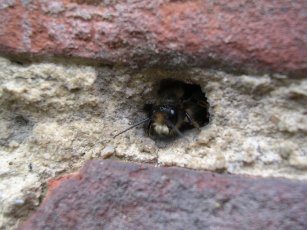 The walls of the house are built with bricks produced locally, and lime mortar. In places, mason bees live in holes in this mortar. They are very active on warm days in the spring, collecting pollen to feed their larvae, and mud to wall up the individual cells in the hole in which the larvae will develop.
The walls of the house are built with bricks produced locally, and lime mortar. In places, mason bees live in holes in this mortar. They are very active on warm days in the spring, collecting pollen to feed their larvae, and mud to wall up the individual cells in the hole in which the larvae will develop.
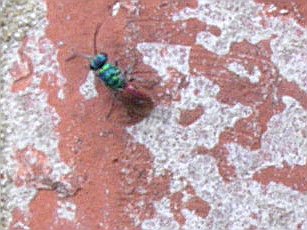 The ruby tailed wasp is a specialist parasitoid of mason bees - it lays eggs in mason bee nests, and it's larvae develop within the mason bee larvae. We don't have a larger photo of this insect - they don't stay still for long, this image is cut from a larger photo and has been enhanced to try to improve the focus of a rather poor original photograph. We thought it worth including because this is such a pretty insect, but we'll replace it if we manage to get a better shot.
The ruby tailed wasp is a specialist parasitoid of mason bees - it lays eggs in mason bee nests, and it's larvae develop within the mason bee larvae. We don't have a larger photo of this insect - they don't stay still for long, this image is cut from a larger photo and has been enhanced to try to improve the focus of a rather poor original photograph. We thought it worth including because this is such a pretty insect, but we'll replace it if we manage to get a better shot.
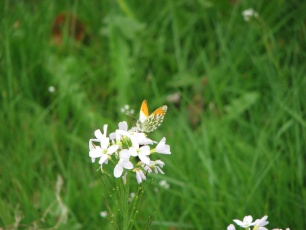 Only the male orange tip butterfly has the characteristic orange markings. The orange markings are also only visible when its wings are open - when at rest, it often closes its wings, showing only the camouflaged markings on the underside.
Only the male orange tip butterfly has the characteristic orange markings. The orange markings are also only visible when its wings are open - when at rest, it often closes its wings, showing only the camouflaged markings on the underside.
 The female orange tip butterfly is very different from the male, although the markings on the underside of the wings, and the colouration of the eyes are similar. This species seems to do well in our garden, perhaps because we have a population of garlic mustard.
The female orange tip butterfly is very different from the male, although the markings on the underside of the wings, and the colouration of the eyes are similar. This species seems to do well in our garden, perhaps because we have a population of garlic mustard.
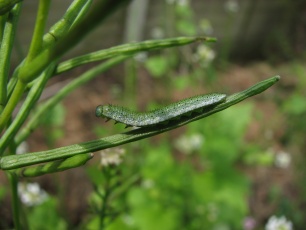 The larva of the orange tip butterfly
The larva of the orange tip butterfly
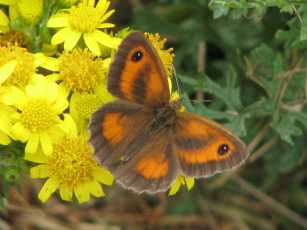 Gatekeeper butterfly (Pyronia thithonus). These are particularly attracted to the flowers on the oregano each August, although this one was photographed on ragwort flowers.
Gatekeeper butterfly (Pyronia thithonus). These are particularly attracted to the flowers on the oregano each August, although this one was photographed on ragwort flowers.
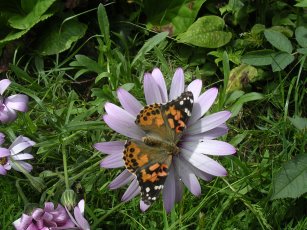 Painted Lady butterfly (Vanessa cardui). There is another photo of this species on the Desktop Backgrounds page, in both widescreen and normal (4:3) format.
Painted Lady butterfly (Vanessa cardui). There is another photo of this species on the Desktop Backgrounds page, in both widescreen and normal (4:3) format.
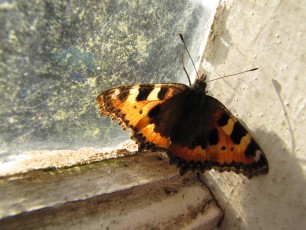 This small tortoiseshell butterfly (Aglais urticae) had obviously hibernated in an outbuilding. We found it fluttering against the window in early April, so photographed it before releasing it.
This small tortoiseshell butterfly (Aglais urticae) had obviously hibernated in an outbuilding. We found it fluttering against the window in early April, so photographed it before releasing it.
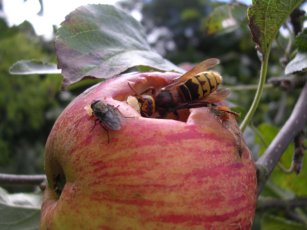 Hornet
Hornet
This is the largest of the wasp family found in the UK, but it is also the most docile and is moderately rare. A nearby colony discovered the overripe fruit on this Laxton's Fortune apple tree. The fly next to the hornet gives some idea of scale.
The commonest species of wasp in the UK is the common wasp (Vespula vulgaris) (known in the USA as "yellowjackets") but two new species are now spreading through the UK. The median (or German) wasp (Dolichovespula media) is now common in many areas, and is more likely to attack people due to its habit of making its nest in shrubs and undergrowth where they are more likely to be disturbed. It is slightly larger, and often has somewhat darker colouration than the common wasp.
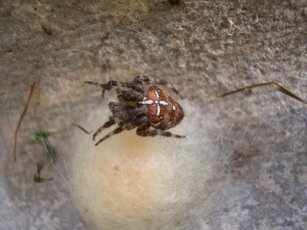 A garden spider with her eggs. OK, she's not an insect - spiders are arachnids, as are harvestmen, ticks, mites and scorpions. Insects
and arachnids are both arthropods (along with crustaceans and various fossil groups such as trilobites).
A garden spider with her eggs. OK, she's not an insect - spiders are arachnids, as are harvestmen, ticks, mites and scorpions. Insects
and arachnids are both arthropods (along with crustaceans and various fossil groups such as trilobites).
The garden spider is also known as the cross spider - for obvious reasons. It is one of the commonest orb-web spiders in our garden.
We also regularly see wolf spiders, sometimes with eggs as in this photo, or occasionally with their young on their backs, as here.
A relatively recent introduction to the UK is the wasp spider (Argiope bruennichi) - it is believed that this species was probably introduced from continental Europe early in the 20th century. The egg sacs are fixed to long grass, so this species can only thrive on undisturbed grass.
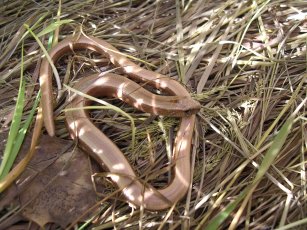 We particularly enjoy the population of slow-worms which live down the garden. Slow-worms are legless lizards, not snakes. They
mostly eat slugs and snails, so are definitely a Good Thing.
We particularly enjoy the population of slow-worms which live down the garden. Slow-worms are legless lizards, not snakes. They
mostly eat slugs and snails, so are definitely a Good Thing.
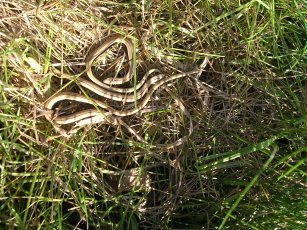 Young slow-worms are particularly beautiful - pale gold along the sides, with a narrow dark brown stripe along the middle of the back.
As they mature, their colours darken. If attacked, a slow-worm can drop its tail - presumably predators would be distracted by the still
twitching tail whilst their prey eascaped. Slow-worms can partially re-grow their tails, but never regain their original appearance.
Young slow-worms are particularly beautiful - pale gold along the sides, with a narrow dark brown stripe along the middle of the back.
As they mature, their colours darken. If attacked, a slow-worm can drop its tail - presumably predators would be distracted by the still
twitching tail whilst their prey eascaped. Slow-worms can partially re-grow their tails, but never regain their original appearance.
Slow-worms can live for 50 years. We have one or two very large, old individuals down the garden. Here is a photo of one - the dead leaves in the photo are beech leaves, it is probably about 50cm long. Here is a closeup view.
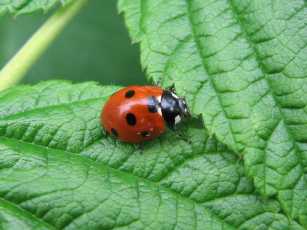 The seven-spot ladybird has always been a part of the English countryside, loved both by children (because of its bright colour) and by gardeners (because it eats the aphids which would otherwise damage their plants). We are lucky in having a wide range of different ladybird species visit our garden, because of the range of habitats in the vicinity.
The seven-spot ladybird has always been a part of the English countryside, loved both by children (because of its bright colour) and by gardeners (because it eats the aphids which would otherwise damage their plants). We are lucky in having a wide range of different ladybird species visit our garden, because of the range of habitats in the vicinity.
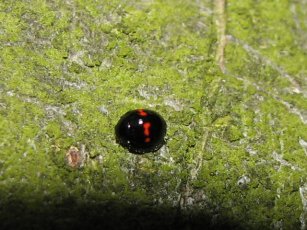 The heather ladybird (Chilocorus bipustulatus) is less common, and is easily mistaken for the melanic form (red spots on black background) of some more common species. It is also smaller than many other species. it's small size and dark colour makes it difficult to photograph well with amateur equipment (must get a ring flash!). This one was on the bark of an apple tree.
The heather ladybird (Chilocorus bipustulatus) is less common, and is easily mistaken for the melanic form (red spots on black background) of some more common species. It is also smaller than many other species. it's small size and dark colour makes it difficult to photograph well with amateur equipment (must get a ring flash!). This one was on the bark of an apple tree.
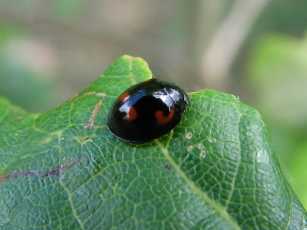 Pine ladybird (Exochomus quadripustulatus). The comma shape of the anterior red spot, and the small "rim" at the base of the ladybird are its identifying features.
Pine ladybird (Exochomus quadripustulatus). The comma shape of the anterior red spot, and the small "rim" at the base of the ladybird are its identifying features.
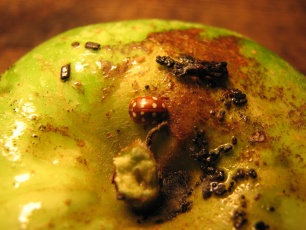 The cream spot ladybird has 14 spots, which gives it its latin name of Calvia quattuordecimguttata (also sometimes written as Calvia 14-guttata). This one was hiding near the stalk of a bramley apple in early October, so may have been thinking of hibernating there. The alignment of six of the spots in a line across the wing-cases is usually a distinguishing feature (click on the photo to see a larger version in which this is more visible).
The cream spot ladybird has 14 spots, which gives it its latin name of Calvia quattuordecimguttata (also sometimes written as Calvia 14-guttata). This one was hiding near the stalk of a bramley apple in early October, so may have been thinking of hibernating there. The alignment of six of the spots in a line across the wing-cases is usually a distinguishing feature (click on the photo to see a larger version in which this is more visible).
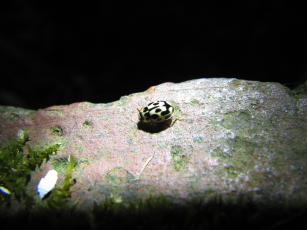 The 14 spot ladybird (Propylea quattuordecimpunctata or P.14-punctata) also has (surprise!) 14 spots, although the pattern can vary; the spots near the middle of the back often merge together, and also with the spots to each side (as in this photo.
The 14 spot ladybird (Propylea quattuordecimpunctata or P.14-punctata) also has (surprise!) 14 spots, although the pattern can vary; the spots near the middle of the back often merge together, and also with the spots to each side (as in this photo.
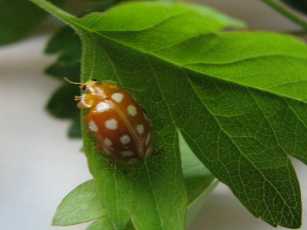 The orange ladybird looks very similar to the cream-spot but usually has 16 spots and is slightly larger. Just to confuse things, the orange ladybird has been found with anything from 12 to 16 spots.
The orange ladybird looks very similar to the cream-spot but usually has 16 spots and is slightly larger. Just to confuse things, the orange ladybird has been found with anything from 12 to 16 spots.
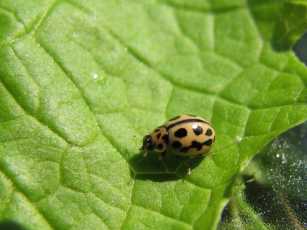 However, the 16 spot ladybird usually has 16 spots, but 3 or 4 of these spots usually merge into an elongated shape on each side; it has also been found with between 13 and 18 spots. It is very similar to the 14 spot ladybird, which has similar colouring and again has variable numbers of spots. We think that this one is a 16-spot, but can't be 100% certain. (The best source of information on UK ladybirds is at www.ladybird-survey.org
However, the 16 spot ladybird usually has 16 spots, but 3 or 4 of these spots usually merge into an elongated shape on each side; it has also been found with between 13 and 18 spots. It is very similar to the 14 spot ladybird, which has similar colouring and again has variable numbers of spots. We think that this one is a 16-spot, but can't be 100% certain. (The best source of information on UK ladybirds is at www.ladybird-survey.org
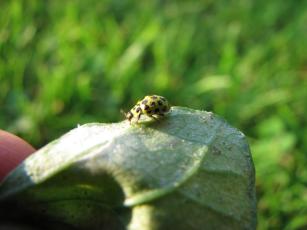 The 22 spot ladybird (Psyllobora vigintiduopunctata or Psyllobora 22-punctata) has less variable spot numbrs, although the exact size and arrangement of spots can still vary.
The 22 spot ladybird (Psyllobora vigintiduopunctata or Psyllobora 22-punctata) has less variable spot numbrs, although the exact size and arrangement of spots can still vary.
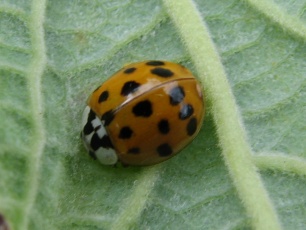 Unfortunately, the harlequin ladybird has recently appeared in this part of Britain. It is not a native species, but was originally introduced to parts of America and Europe to control crop pests such as aphids and scale insects. It then spread across Europe, reaching Britain in 2004. Unfortunately it (and it's larvae) are voracious predators, not only of pests, but also of other insects including native species of ladybird. We'd only seen the occasional harlequin ladybird until 2008, but they then became the commonest species in our garden. We're now very worried that the native species will all disappear.
Unfortunately, the harlequin ladybird has recently appeared in this part of Britain. It is not a native species, but was originally introduced to parts of America and Europe to control crop pests such as aphids and scale insects. It then spread across Europe, reaching Britain in 2004. Unfortunately it (and it's larvae) are voracious predators, not only of pests, but also of other insects including native species of ladybird. We'd only seen the occasional harlequin ladybird until 2008, but they then became the commonest species in our garden. We're now very worried that the native species will all disappear.Harlequin ladybirds can vary enormously in colour and pattern; guidance on recognition is available at www.harlequin-survey.org/. If you find one, kill it!
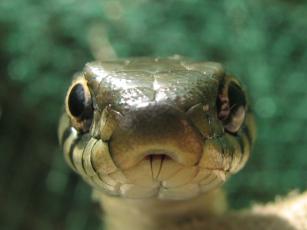 We regularly see grass snakes in the rough area at the bottom of the garden, but they move very quickly if disturbed, so we haven't managed to photograph one until now. This one had got thoroughly tangled in some netting used to protect fruit from the birds - we had to cut the netting in several places to release it, and took the opportunity for a couple of photographs at the same time.
We regularly see grass snakes in the rough area at the bottom of the garden, but they move very quickly if disturbed, so we haven't managed to photograph one until now. This one had got thoroughly tangled in some netting used to protect fruit from the birds - we had to cut the netting in several places to release it, and took the opportunity for a couple of photographs at the same time.
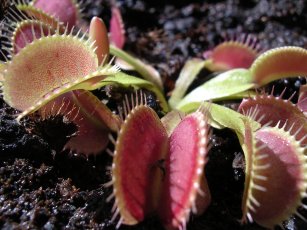 The Venus fly trap is not native to the UK, and was photographed in the greenhouse - so perhaps not quite appropriate for "down the garden"
- but it's so commonly sold in garden centres, and so commonly lasts only a few months that it justifies some brief notes.
The Venus fly trap is not native to the UK, and was photographed in the greenhouse - so perhaps not quite appropriate for "down the garden"
- but it's so commonly sold in garden centres, and so commonly lasts only a few months that it justifies some brief notes.
If you have a venus fly trap, it is very easy to keep if you follow these rules: (a) Don't water it with tap water or bottled water, only use rainwater. (b) Don't use any plantfood. (c) Keep it permanently standing in 1-2cm of (rain)water (d) Put it in the sunniest window in the house (South-facing if possible). (e) Don't feed it with lumps of meat etc - it will catch enough flies by itself. That's it - simple!
If you want to grow Venus fly traps from seed, this is again very easy. Allow an existing plant to set seed on one or two flower shoots (remove the rest so they don't weaken the plant too much). As soon as the seed pods have turned black and started to split, collect the seed and sow immediately. Fill a pot with a mixture of peat (not a peat-based houseplant compost), sand and a little finely crushed charcoal. Water well with rainwater and allow to drain. Sprinkle the seed on the surface and very lightly water (rainwater!) to settle the seed into the surface. Allow to drain, then put the pot into a sealed plastic bag and put it in the fridge for 14 days. Remove, leave it in the bag and put it on a warm, sunny windowsill. Once the seedlings have germinated and started to establish, open the top of the bag, gradually allowing more air in over several weeks. Water with rainwater to keep the pot standing in 1-2cm of water. That's it - easy!
Please also look at the page of interesting objects we found when digging in the garden.
Some of the species we have seen in (or above) our garden
We update this list from time to time, and have also recently started making links from some entries on the list to our photographs - but have many more still to do, so please check back again in a few weeks. Again, all these photograps were taken in our garden or house.Please Let us know if you think we've incorrectly identified any of these.
Birds
- Bluetit (Parus caeruleus)
- Great tit (Parus major)
- Coal tit (Parus ater)
- Long-tailed tit (Aegithalos caudatus)
- Bullfinch (Pyrrhula pyrrhula)
- Chaffinch (Fringilla coelebs)
- Goldfinch (Carduelis carduelis) (link shows goldfinches and siskins together)
- Greenfinch (Carduelis chloris)
- Blackbird (Turdus merula)
- Song thrush (Turdus philomelos)
- Robin (Erithacus rubecula) (on nest)
- Wren (Troglodytes troglodytes)
- House sparrow (Passer domesticus)
- Hedge sparrow (Prunella modularis)
- Siskin (Carduelis spinus) (link shows goldfinches and siskins together)
- Starling (Sturnus vulgaris)
- Nuthatch (Sitta europaea)
- Goldcrest (Regulus regulus)
- Greater spotted woodpecker (Dendrocopos major)
- Green woodpecker (Picus viridis)
- Magpie (Pica pica)
- Jay (Garrulus glandarius)
- House martin (Delichon urbica)
- Swift (Apus apus)
- Swallow (Hirundo rustica)
- Wood pigeon (Columba palumbus)
- Collared dove (Streptopelia decaocto)
- Pheasant (Phasianus colchicus)
- Canada goose (Branta canadensis)
- Sparrowhawk (Accipiter nisus)
- Grey Heron (Ardea cinerea)
- Pied Wagtail (Motacilla alba)
- Sputincendia mitchellii rafoides
Amphibians, snakes and reptiles
- Common frog (Rana temporaria)
- Common toad (Bufo bufo)
- Common newt (Triturus vulgaris)
- Grass snake (Natrix natrix)
- Slow worm (Anguis fragilis)
- Common lizard (Lacerta vivipara)
Mammals
- Hedgehog (Erinaceus europæus)
- Brown long-eared bat (Plecotus auritus)
- Common pipistrelle bat (Pipistrellus pipistrellus)
- Fox (Vulpes vulpes)
- Grey squirrel (Sciurus carolinensis)
- Brown rat (Rattus norvegicus)
- Wood mouse (Apodemus sylvaticus)
- vole - probably Field vole (Microtus agrestis)
- Next door's cat (Felix domestica)
- Children! (Homo sapiens)
Insects, spiders etc.
- Peacock butterfly (Inachis io)
- Red Admiral butterfly (Vanessa atalanta)
- Painted Lady butterfly (Vanessa cardui)
- Comma butterfly (Polygonia c-album) and showing "comma" on underside of wing
- Small tortoiseshell butterfly (Aglais urticae)
- Speckled wood butterfly (Pararge ægeria)
- Gatekeeper butterfly (Pyronia tithonus)
- Meadow Brown butterfly (Maniola jurtina)
- Ringlet butterfly (Aphantopus hyperantus)
- Holly blue butterfly (Celastrina argiolus) adult , egg closeup , egg and early instar larva and late instar larva
- Common blue butterfly (Polyommatus icarus) male , female and female underside
- Small copper butterfly (Lycaena phlaeas)
- Large white butterfly (Pieris brassicae)
- Small white butterfly (Pieris rapae)
- Orange tip butterfly (Anthocharis cardamines)male, , male underside and female
- Small Skipper butterfly (Thymelicus sylvestris)
- Elephant hawk moth (Deilephila elpenor)
- Eyed hawk moth (Smerinthus ocellata)
- Humming bird hawk moth (Macroglossum stellatarum)
- Vapourer moth (Orgyia antiqua) male and female
- Cinnabar moth (Tyria jacobaeae) and larvae
- White Plume Moth (Pterophorus pentadactyla)
- Emmelina monodactyla a plume moth, known in N.America as the Morning Glory Plume Moth.
- Amblyptilia punctidactyla (a plume moth)
- Green arches moth (Anaplectoides prasina)
- Setaceous Hebrew Character moth (Xestia c-nigrum)
- Nemophora degeerella, a longhorn moth
- (Adela reamurella), a longhorn moth (with a bit of dandelion fluff caught on one of it's antennae!)
- Small Magpie moth (Eurrhypara hortulata)
- Garden Carpet moth (Xanthorhoe fluctuata)
- Yellow shell moth (Camptogramma bilineata)
- July belle moth Scotopteryx luridata
- Shaded broad-bar moth (Scotopteryx chenopodiata)
- Herald moth (Scoliopteryx libatrix)
- Small phoenix moth (Ecliptopera silaceata)
- Pale Tussock moth (Calliteara pudibunda)
- Orange moth (Angerona prunaria)
- Brimstone moth (Opisthograptis luteolata)
- Swallow-tailed moth (Ourapteryx sambucaria)
- Common White Wave moth (Cabera pusaria)
- Grey dagger moth (Acronicta psi)
- Light Brown Apple moth (Epiphyas postvittana)
- Brown dotted clothes moth (Niditinea fuscella)
- Pyrausta aurata.jpg
- Blood vein moth (Timandra comae)
- Light Emerald moth (Campaea margaritata)
- Riband wave moth (Idaea aversata)
- Small fan-footed wave moth (Idaea biselata f.fimbriolata)
- Acleris cristana
- Angle shades moth (Phlogophora meticulosa)
- Silver Y moth (Autographa gamma)
- Sallow moth (Xanthia icteritia)
- Barred Sallow moth (Xanthia aurago)
- Satellite moth (Eupsilia transversa)
- Six-spot burnet moth (Zygaena filipendulae)
- Cinnabar moth (Tyria jacobaeae) , side view and larvae on ragwort
- White ermine moth (Spilosoma lubricipeda)
- Buff arches moth (Habrosyne pyritoides)side view and dorsal view
- Diamond-back moth (Plutella xylostella)
- Leek moth (Acrolepiopsis assectella) damage on leek, larva from within mine in leek leaf, pupa in coccoon and adult
- Uncertain - possibly a Nomophila species?
- Halesus radiatus (a caddis fly)
- Green lacewing (Chrysopa perla) (but more blue-green than some other species!)
- Moth flies, possibly Psychoda grisescens photographed on horse manure
- Scorpion fly Panorpa germanica
- Large bee fly Bombylius major
- Large red damselfly (Pyrrhosoma nymphula)
- Azure damselfly (Coenagrion puella)
- Beautiful demoiselle (Calopteryx virgo)
- Common darter dragonfly (Sympetrum striolatum)
- Golden-ringed dragonfly (Cordulegaster boltonii)
- Migrant hawker dragonfly (Aeshna mixta) and closeup of eyes
- Violet ground beetle (Carabus violaceus)
- Lesser stag beetle, male (Dorcus parallelipipedus) and female
- Poecilus cupreus (previously known as Pterostichus cupreus)
- Sexton beetle (burying beetle) (Nicrophorus vespillo)
- Maybug ( or cockchafer) (Melolontha melolontha)
- Spotted longhorn beetle (Strangalia maculata)
- Stenurella melanura (a longhorn beetle) (female) and male
- Grammoptera ruficornis (a longhorn beetle)
- Fat legged beetle (Oedemera nobilis), male and female
- Red-headed cardinal beetle (Pyrochroa serraticornis)
- Soldier beetle (also known as the bonking beetle) (Rhagonycha fulva) (the orange legs distinguish this from the Cardinal beetle above.)
- Common malachite beetle (Malachius bipustulatus)
- 7-spot ladybird (Coccinella septempunctata)
- Cream spot ladybird (Calvia quattuordecimguttata)
- 14 spot ladybird (Propylea quattuordecimpunctata)
- 16-spot ladybird (Tytthaspis sedecimpunctata)
- Orange ladybird (Halyzia sedecimguttata)
- Heather ladybird (Chilocorus bipustulatus)
- Pine ladybird Exochomus quadripustulatus)
- Harlequin ladybird (Harmonia axyridis)
- 22 spot ladybird (Psyllobora vigintiduopunctata)
- Thistle tortoise beetle (Cassida rubiginosa)
- Rosemary leaf beetle (Chrysolina americana)
- Asparagus beetle (Crioceris asparagi) and larva
- Scarlet lily beetle (Lilioceris lilii)
- Ragwort flea beetle (Longitarsus jacobaeae)
- Anthrenus sp., probably A.verbasci, the varied carpet beetle
- Hazel leaf roller weevil (Apoderus coryli)
- Garden spider (or cross spider) (Araneus diadematus)
- Wolf spider (Paradosa amentata)
- Wasp spider (Argiope bruennichi)
- Tegenaria species (probably T.gigantea, the giant house spider)
- Daddy long legs spider (Pholcus phalangioides)
- Crab spider (possibly Misumena vatia?)
- Flower crab spider (Misumena vatia)
- Steatoda bipunctata
- Nursery web spider (Pisaura mirabilis)
- Jumping spiders
- Honey bee (Apis mellifera)
- Buff tailed bumble bee (Bombus terrestris)
- Red tailed bumble bee (Bombus lapidarius)
- Common carder-bee (Bombus pascuorum)
- Red mason bee (Osmia rufa)
- Leaf-cutter bee (Megachile spp.)
- Hornet (Vespa crabro)
- Common wasp (Vespula vulgaris)
- Median wasp (Dolichovespula media)
- Ruby tailed wasp (Chrysis ignita)
- An Encarsia wasp, probably Encarsia inaron, but possibly E.tricolor (a parasite of brassica whitefly)
- Large rose sawfly (probably Arge pagana)adult and larvae
- Solomon's seal sawfly (Phymatocera aterrima)
- Speckled bush cricket (Leptophyes punctatissima) (This photo is of the nymph stage)
Molluscs
- Garden snail (Helix aspersa)
- Garlic snail (Oxychilus alliarius)
- White lipped snail Cepaea hortensis)
- Field slug (Deroceras reticulatus)
- Black slug (Arion ater)
- Yellow slug (Limacus flavus) (NB this was previously identified here (incorrectly) as a leopard slug (Limax maximus) - thanks to Heike Kappes at Universität zu Köln for the correction)
Plants
- Primrose (Primula vulgaris)
- Teasel (Dipsacus fullonum)
- Common sorrel (Rumex acetosa)
- Meadow buttercup (Ranunculus acris)
- Creeping buttercup (Ranunculus repens)
- Lesser celandine (Ranunculus ficaria)
- Birdsfoot trefoil (Lotus corniculatus)
- Oxeye daisy (Leucanthemum vulgare)
- Knapweed (Centaurea nigra)
- Wild carrot / Queen Anne's lace (Daucus carota)
- Lady's smock (Cardamine pratensis)
- Garlic mustard (Alliaria petiolata)
- Salad burnet (Sanguisorba minor)
- Great mullein Verbascum thapsus
- Lady's bedstraw (Galium verum)
- Cleavers (Galium aparine)
- Thyme-leaved speedwell (Veronica serpyllifolia)
- Little Robin (Geranium purpureum)
- Herb Bennet (Geum urbanum)
- Primrose (Primula vulgaris)
- Common toadflax (Linaria vulgaris)
- American willowherb (Epilobium ciliatum)
- Great Willowherb (Epilobium hirsutum)
- Broad-leaved willowherb (Epilobium montanum)
- Rosebay willowherb (Chamerion angustifolium)
- Scarlet pimpernel (Anagalis arvensis)
- English Oak (Quercus robur)
- European ash (Fraxinus excelsior)
- Rowan (Sorbus aucuparia)
- Holly (Ilex acquifolium)
- Common Hawthorn (Cratægus monogyna)
- Blackthorn (sloe) (Prunus spinosa)
- Field maple (Acer campestre)
- Hornbeam Carpinus betulus)
- Dog rose (Rosa canina)
- Common blackberry (Rubus fruticosus)
- Beech (Fagus sylvatica)
- Guelder rose (Viburnum opulus)
- Spindle tree (Euonymus europæus)
- Buckthorn (Rhamnus cathartica)
- Elder (Sambucus nigra)
- Annual meadowgrass (Poa annua)
- Yorkshire fog (Holcus lanata)
- Cocksfoot (Dactylis glomerata)
- Field woodrush (Luzula campestris)
- Stinkhorn fungus (Phallus impudicus) and the early "egg" stage
- Trametes versicolor, sometimes called the "turkey tail fungus"
- Fawn mushroom (Pluteus cervinus)
- Honey fungus (Armillaria mellea)
